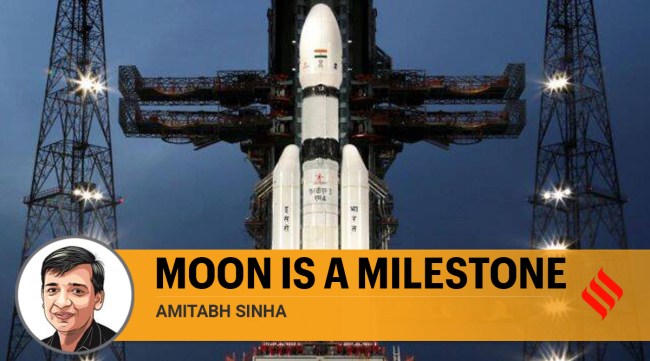Opinion Behind Chandrayaan 3’s launch: ISRO’s moon milestone
Success of Chandrayaan could result in a big boost to ISRO's profile. It would also bring in greater scrutiny and demands for accountability.
 Russia has had decades of advantage in sending human beings to space. (Express File Photo)
Russia has had decades of advantage in sending human beings to space. (Express File Photo) The kind of excitement generated by ISRO’s space launches is amazing — not just the Chandrayaan series, but even the routine satellite launches. These are followed very keenly, and cheered loudly. The Chandrayaan and Mangalyaan missions have obviously been extra-special. They signal the coming of age of India’s space programme, a shift in strategy, and a stepping stone to much bigger things in space travel and exploration.
It has not been an easy journey for ISRO. The agency has had to toil in isolation for decades with very limited resources. Outsiders would often treat India’s space programme with derision and ridicule — as a fanciful dream of a pretender wanting to play with the big boys — and not worthy of partnering with. ISRO itself seemed focussed on utilitarian objectives — enabling telecommunications, telemedicine and tele-education, broadcasting, or setting up remote sensing satellites. Space and planetary exploration was nowhere in priority. In fact, Professor Yash Pal, the venerated scientist and science communicator, once described the initial stages of India’s space programme as “not only a technological programme but almost a sociological programme”.
He wrote that the Space Application Centre in Ahmedabad, at one time, had 250 social scientists “who were working all over the country to find out what is communication and how to talk to people”.
But ISRO was also blessed with a set of dreamers — starting with Vikram Sarabhai and several of his contemporaries — who were fascinated with space science and planetary exploration and were passionate about making India an active participant in these. India’s first Chandrayaan mission could happen only in 2014, but discussions for a lunar probe had been going on since the 1980s.
Today, no one sees India’s space programme as an expensive hobby of a low-income economy. It is an essential adjunct of a rising global power that is gaining strength in every sphere. When it comes to exploring the moon, at least, India is not very far behind the other major space-faring nations. This is not true in the case of deep space exploration, for example, where NASA has a very clear lead over everyone else. Russia has had decades of advantage in sending human beings to space. But, with regard to lunar explorations, all the countries are doing more or less similar things right now, notwithstanding the experience of landing humans on the moon’s surface five decades ago. India’s Chandrayaan programme is already making valuable contributions to the global knowledge pool. Instruments aboard Chandrayaan-1 had confirmed the presence of water over the moon, and if Chandrayaan-3 can make a successful landing, it would be the first time that any lunar probe would be exploring the polar regions of the moon.
But Chandrayaan-3 is only a small milestone, though extremely important, in a journey that has just begun for ISRO. The ability to make a soft landing on a planetary body is a crucial technology that can enable ISRO to do a variety of things that it otherwise can’t. If it cannot land a craft on the moon, for example, the space agency cannot explore its surface or know about the mineralogy of the moon. This can hamper its ability to carry out, or participate in, other scientific missions to the moon. Chandrayaan-3 is important from another aspect as well. The failure of Chandrayaan-2 has been hanging like a heavy weight around ISRO’s neck. Chandrayaan-3 ideally should have been a progression over Chandrayaan-2, but without the landing technology, it is difficult for ISRO to move ahead.
It is important for ISRO to get done with this, and start focussing on other missions. There are a series of important ones lined up — Gaganyaan, India’s first mission to carry humans in space, a mission to an observation point for the Sun, and another one to Venus. The timelines of all of these have been affected because of the failure of Chandrayaan-2, though the pandemic also has to take the blame.
As ISRO gets ready to join the big game in space exploration, it will most likely also face greater scrutiny and demands for accountability. For a very long time, ISRO has been treated with extreme affection by the Indian public. Whatever it did became a matter of national pride. Its failures, and delays, were ignored or glossed over, and its successes celebrated.
This will most likely change as it gets into the more serious business of scientific space exploration. It will compete, and be assessed, against the best space agencies in the world.
Space is no longer a benign exercise in the pursuit of science. It has extremely important strategic, economic and even military dimensions. It brings concrete power advantages. It is no coincidence that every major power in the world also is a major space-faring nation. That is why it is so crucial that ISRO moves ahead quickly in this new phase. Incidentally, the future of space is also going to be much more collaborative. The kind of missions that are being considered, and the kind of infrastructure that might need to be created in space to facilitate these, would be beyond the capabilities of any single country. But countries will collaborate with only those who have something useful to contribute, and bring value to the partnership.
amitabh.sinha@expressindia.com






